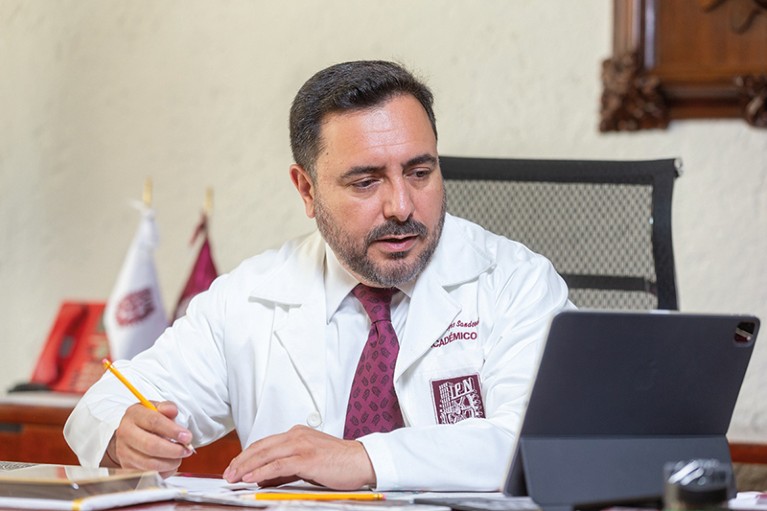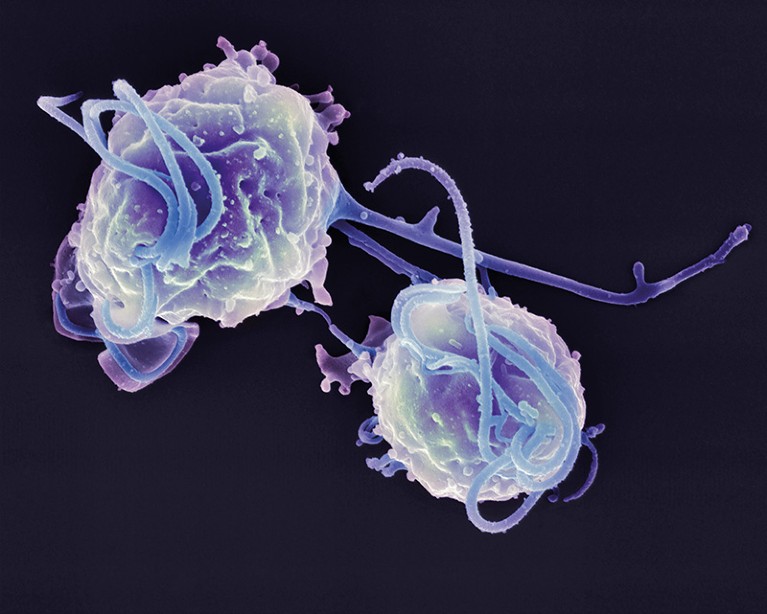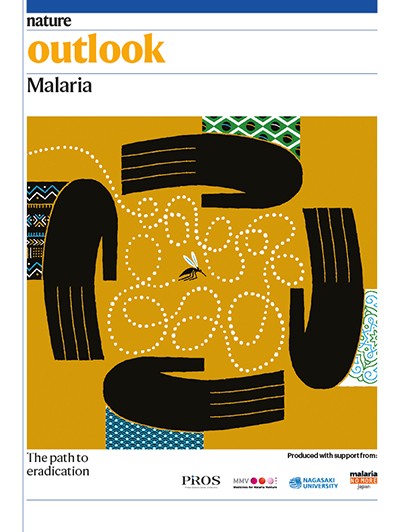
Arturo Reyes-Sandoval says developing a Plasmodium vivax vaccine has been challenging.Credit: IPN
Most malaria researchers focus on the disease-causing parasite Plasmodium falciparum, the most prevalent species of Plasmodium in Africa. But elsewhere, another parasite dominates: Plasmodium vivax. Efforts to address malaria caused by this species lag behind those of P. falciparum, including the development of effective vaccines. Arturo Reyes-Sandoval, a vaccinologist at the National Polytechnic Institute in Mexico City and the University of Oxford, UK, spoke to Nature about why a P. vivax malaria vaccine should be on researchers’ most wanted list, and how close he and his colleagues are to developing one.
How does P. vivax compare with other species of malaria parasite?
There are around 200 species of malaria parasite that can infect mammals, birds and reptiles. P. vivax is the most widely distributed form of malaria parasite in humans, and it is dominant in the Western Pacific and in highly populated areas of Latin America and Asia.
By comparison, P. falciparum is present mainly in Africa, and is responsible for high levels of mortality, especially in children. Two other species — Plasmodium malariae and Plasmodium ovale — are less prevalent. A fifth malaria parasite, Plasmodium knowlesi, infects monkeys in southeast Asia, and can be transmitted from animal hosts to people by mosquitoes, causing a special zoonotic form of malaria.
Part of Nature Outlook: Malaria
Why has malaria caused by P. vivax been neglected?
Attention is directed towards P. falciparum because it is deadlier than P. vivax. But P. vivax parasites can also cause severe disease — people who are infected might have to live with a debilitating condition for a long time. Like many neglected pathogens, P. vivax might not cause as many deaths as other parasites, but it still causes chronic disease. And when a pathogen is as common as P. vivax, that results in a high disease burden that contributes to poverty and has a big social impact.
Despite this, research funding is much harder to obtain when you work with P. vivax than when you work with P. falciparum. This has resulted in a huge gap in our knowledge of the basic biology of the parasite.
How is dealing with P. vivax different from working with P. falciparum?
We face two major problems. First, P. vivax is present in the world’s most highly populated regions, making it extremely difficult to control. India, which has just become the world’s most populous country, is one of the places with the highest burden of P. vivax malaria. Producing enough vaccine to protect these populations is going to be extremely difficult.
The other big problem is that P. vivax is more complex biologically than P. falciparum is. P. vivax can hide inside the liver of humans as hypnozoites — a dormant form of the parasite. These hypnozoites can stay hidden for months or years at a time, then emerge back into the blood and cause relapses throughout a person’s life.
What options do we have to respond to P. vivax malaria?
Currently, there is only one drug for treating relapses of P. vivax: primaquine. Unfortunately, its use is not widespread because of side effects such as the destruction of red blood cells. Other drugs are being investigated, but there doesn’t seem to be anything on the horizon that will effectively treat P. vivax infection.
This means we have to take a preventative approach, and the gold standard would be a vaccine. The first vaccine for malaria caused by P. falciparum, called RTS,S, is now available. For P. vivax, however, there are only a few vaccines in clinical trials and the results have been quite modest.

Plasmodium vivax is the most widespread species of malaria parasite.Credit: Dennis Kunkel Microscopy/SPL
How do you go about devising a vaccine for use against P. vivax?
First, we have to think about what stage of the parasite’s life cycle we want to attack — different stages require different approaches. We could target the parasite when it is inside the mosquito to prevent transmission to people; when it first enters the human body from a mosquito bite and before it reaches the liver; or when it re-emerges into the blood, when symptoms start.
I have always thought that preventing parasites entering the liver is our best option. That way, you not only prevent the development of the blood-stage parasites that cause disease, but also avoid the development of hypnozoites that can keep coming back.
We then need to work out what to use to target the parasite in this form, known as a sporozoite. P. vivax has especially high genetic diversity, which means its proteins can take many forms. As a result, the immunity conferred by a vaccine that contains one version of a protein might be specific only to certain strains of a parasite. We also know that the immunity elicited by delivering a protein by itself is not powerful enough to make an effective vaccine. Therefore, we also need to find a way to formulate the vaccine so that it will induce high levels of protection.
What does the vaccine you are developing look like?
We decided to base it on circumsporozoite protein (CSP). This is a major antigen on the surface of Plasmodium parasites in the sporozoite form, in which they enter the body. An immune response directed against CSP could prevent invasion of the liver.
This is a common target. The existing RTS,S vaccine comprises virus-like particles that express two regions of the CSP protein carried by P. falciparum sporozoites. Another P. falciparum vaccine in development, called R21, also contains CSP. We have found that virus-like particles that express CSP are also good vehicles to elicit a protective immune response to P. vivax.
Our vaccine, which we call Rv211, includes copies of two of the most common forms of CSP found on P. vivax sporozoites to protect against all the major strains. It can be produced in very high yields by using an expression platform based on Pichia pastoris yeast. We found that the vaccine can induce complete protection in mice, even when we used small doses of the vaccine. Another P. vivax vaccine candidate that used a different protein failed to induce sterile immunity in mice, so Rv21 is looking promising.
What challenges have you faced in producing a P. vivax vaccine candidate?
Because P. vivax does not grow in the lab as easily as P. falciparum, we rely on animal models to test malaria vaccines. Good animal models would allow us to test different combinations of proteins, vehicles and adjuvants (ingredients used to create a stronger immune response), and then take only the best ones forward to human trials. Unfortunately, there is a lack of good animal models for P. vivax vaccines, and that has made development very slow.
More from Nature Outlooks
We have been working on this problem for years, and have now developed transgenic versions of the rodent parasite Plasmodium berghei that express P. vivax proteins. We can, for example, make P. berghei sporozoites that display P. vivax CSP, which is what we used in our mouse trials of Rv21.
Another challenge is that malaria vaccines are more efficacious when mixed with an adjuvant — RTS,S uses one called AS01, and our vaccine candidate currently includes one called Matrix-M. The best adjuvants have to be licensed from pharmaceutical companies, which isn’t always easy to do and adds to the cost of the vaccines. To avoid that issue, we are testing ways to deliver parasite proteins that might remove the need for an adjuvant. One of those alternative platforms is a viral vector2, which can be genetically modified to elicit specific antibody and T-cell responses. We can now study the efficacy of approaches such as this in our rodent model.
What’s next for Rv21?
We’re now manufacturing Rv21 at the Serum Institute of India in Pune, to assess its toxicology. We hope to have the results this year so we can apply for grants to start a phase I clinical trial in the coming years. The institute in Pune is already making a hepatitis B vaccine that uses a similar platform, so it has the technology required to produce Rv21 for use in people.
We are also analysing different vaccine formulations and searching for suitable vehicles for multivariant, multiantigen combinations3. And we are exploring the possibility of a multistage vaccine, directed at both sporozoites and merozoites — the blood-stage parasite — with malaria researcher Chetan Chitnis at the Pasteur Institute in Paris.
So, although the prospect of protection against P. vivax looks good, vaccines take a long time to develop. As scientists, we have to be very, very patient, and never give up.






More News
Who will make AlphaFold3 open source? Scientists race to crack AI model
These crows have counting skills previously only seen in people
Seed-stashing chickadees overturn ideas about location memory